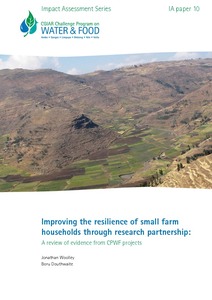Resource information
This paper explores the potential benefits of working to improve the resilience of complex adaptive systems in agriculture and aquaculture through engaging in diverse partnerships among different types of research and development institutions, and the people in those institutions. We use five case studies of CPWF research-for- development efforts to draw lessons about achieving effective results in system resilience. The paper gives concrete examples of effective partnerships and the positive changes that resulted for farmer and fisher communities.
According to the literature (e.g. Sayer and Campbell, 2001), one key to successful attainment of resilience
is the interlinking of at least three system levels. Similarly, it appears from our study that projects need to intervene at three or more system levels, with their corresponding actors, to bring maximum benefit to small rural households. In the CPWF experience presented here, one level often provides the key opportunity to mobilizing the other levels. Hence, diverse partnerships increase the chance of innovation and success when that diversity covers at least three institutional scales, for example, farm households, community-based organizations and regional policy-making. We note that there is therefore likely to be a close link between resilient results and broad partnerships in research and development.
We find evidence that research products produced in this way contributed better to the resilience of rural livelihoods than those typically obtained from “business as usual”, that is, using the science-driven Central Source of Innovation model, and that such contributions were often unexpected; this merits further study beyond the scope of this paper. In most of the cases, the “business as usual” research would not have produced any of the results. In others, some key results, but not the complete set of results, would have been obtained because not all levels of actors would have been present in the research.
The projects discussed in these case studies contributed to resilience of livelihoods because they sped up learning processes that were cognizant and inclusive of different system scales. This provided the checks and balances necessary to avoid promoting a change to the detriment of a long term trend, or of another system user. Involving actors from more system levels increased the ability to analyze, and generated more benefit for more people. By scoping the environment of diverse institutions for ideas, partners picked up good ones quickly. They understood “what is going on”. A further key to success was leadership of the research-for-development teams by results-oriented, committed, well-connected people, accustomed to systems thinking, which was also a result of broader partnerships.


